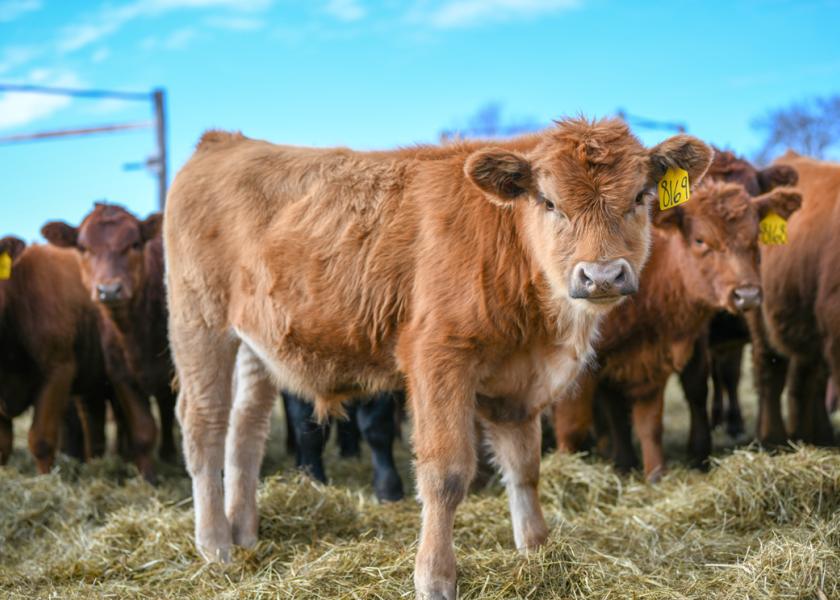Thinking of Backgrounding Calves this Fall?

Cattle prices have responded to lower cattle inventory. If you are keeping up with cattle production news media, nearly every week, someone declares how much feeder calf prices have increased since last year. Sales of 500- to 600-cwt feeder calves are getting close to $300/cwt. Expecting a gross revenue of $1,600 or more for feeder steer calves this fall is not out of the question. Yet, with increasing costs of maintaining a cow, some cow-calf producers may wonder: to increase revenue in 2023, is it worth it to retain calves for feeding during a backgrounding or stocker period?
At an annual cow cost of $1,250 per cow, weaning rate of 90% and scale weight of a steer calf at sale time of 550 lb, the actual breakeven cost would be $252.25/cwt. The margin for this example operation would be $47.50/cwt of steer calf sold. Considering the same scenario for feeder heifer calves, and assuming a sale price on heifers of 500 lb changes the margin from $47.50 to $22.22/cwt. Certainly, steer calves have a greater potential for profit at weaning than their female counterparts.
Considerations for backgrounding the 2023 spring-born calf crop should be based on potential for profit but must also include each operator’s individual production conditions and financial position. If a note is due before the end of 2023, cash may be short and the option to retain calves into 2024 dissipates quickly. If the operator’s financial position affords retaining calves into 2024, then one might consider retaining some or all calves weaned in 2023 to background and sell in 2024.
In addition to the financial position, each operator must make a mental review of their capacity to keep and feed calves during the winter. Although there is a potential to generate additional revenue from keeping calves through winter for sale in the spring, feeding and managing young cattle creates an additional burden on time and resources.
Although feed is the first requirement most of us think of, additional time required to feed and manage young calves, and whether calves have access to water and dry comfortable housing facilities must also figure in this decision.
Retaining calves worth $1,600 to background during winter is a serious investment with real risks. Exposing young, weaned calves to challenges brought on by insufficient water access, poorly ventilated or uncomfortable loafing conditions, and feed mismanagement will lead to illness and death, and reduce any possibility of additional revenue.
Before making any additional considerations regarding backgrounding calves, attention must be paid by each operator to the financial cost of retaining calves beyond weaning. Interest rates climbed to levels not observed for a long time. Similarly, costs to operate a truck or tractor reached higher levels as fuel prices remain high.
Retaining a $1,600-calf to background should be treated as if one had the opportunity to invest this money in a financial operation whether operating capital is one’s own or borrowed. At 8.5% interest rates, carrying $1,600 on a loan for 6 months results in interest costs of $0.22/day. Similarly, running a tractor for 1 hour will likely result in consumption of 4 gallons of diesel or $16/hour with diesel at $4/gallon. Adding labor, as a form of payment for the operator’s effort, adds another $22/hour. As a result, the expense to feed and care for weaned calves, we all lump in as yardage, costs at minimum $38/hour.
Nearly any activity we undertake while farming or ranching takes one hour or more to complete. Assuming there are 100 calves in a backgrounding group, one can expect to charge this operation $0.38/calf daily. When adding interest cost to this calculation, yardage increases to $0.60/calf daily. One might add another $0.05 to $0.20/calf daily to this calculation to include facilities taxes, depreciation, and repair depending on the condition of the facility. These calculations result in yardage fees ranging between $0.65 and $0.80/calf daily.
Feed costs in 2023 and 2024 moderated some from the highs observed in late 2022 but are not what anyone would consider low. Therefore, we may expect to pay from $1.60 to $1.90 for feed per calf daily bringing the grand total daily expense between $2.25 and $2.70 to carry a calf during backgrounding in 2023 and 2024.
Using CME futures and basis projections to determine prices for 550-lb steer and 500-lb heifer calves in November of 2023 and 850-lb steers and 750-lb heifers in March of 2024 resulted in gross revenue margins of approximately $400 per calf regardless of sex or weight. This means that an operator wishing to retain feeder calves in 2023 for sale as yearlings in 2024 is working against breakeven costs of gain (maximum amount of money an operator can spend to break even with costs of raising a calf) of $130/cwt and $160/cwt, respectively, for steers and heifers. Heifers have a greater gross margin because they are undervalued as lightweight feeders.
Thus, operators considering backgrounding calves this fall may take a serious look at marketing their steer calf crop and retaining feeder heifers for sale in 2024 as yearlings. Yet, as indicated above, perhaps the first consideration before these decisions are made is to take a hard look at the financial costs and the operator’s capacity to devote sufficient time and attention to background calves during winter.







